Neuroscience meets School
Internship: Excursion into the world of the brain
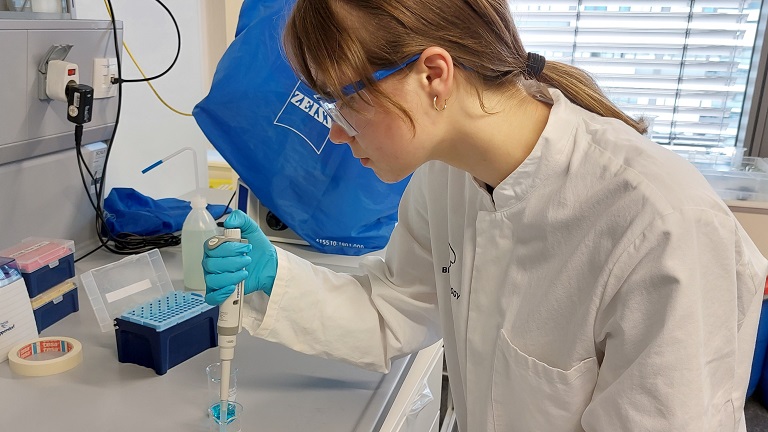
18-year-old Emelie had the chance to look over the shoulders of the SFB 874 scientists in an one week internship.
Read moreOne week with the scientists of the SFB 874
When Emelie entered the campus shortly before the summer holidays and made her way to the GAFO building, she was a little excited.
One week of school internship was ahead of her – in the laboratories of the SFB 874. “It has been my wish to do an internship in the lab for a long time. But until now I was too young for it,” explains Emelie, who took biology as an advanced course at school. “Now I’m very excited to see what’s waiting for me.”
For five days, the pupil from Sprockhövel was offered a varied programme at the Ruhr University in Bochum: Neuronal fundamentals of learning in the research group of Prof. Dr. Jonas Rose, the stress lab in the area of Prof. Dr. Oliver Wolf and biopsychology at the department of Prof. Onur Güntürkün.
The timetable included microscopy, Skinner box training, immunohistochemistry and participation in stress tests and behavioural experiments. “While I really enjoyed everything, I found the neurophysiological studies with the pigeons the most exciting,” sums up the 18-year-old, who will graduate from high school next year.
I will continue on this path and could well imagine starting out in neuroscience after my A-levels.
Emelie, A-level student and school intern for one week at SFB 874
Supervising interns is a win-win situation for both sides.
“The SFB 874 is always happy to give seriously interested pupils an insight into everyday research life as part of a work experience internship. After all, today’s pupils are tomorrow’s neuroscientists and an important multiplier,” says Ursula Heiler, manager of the outreach project at SFB 874.
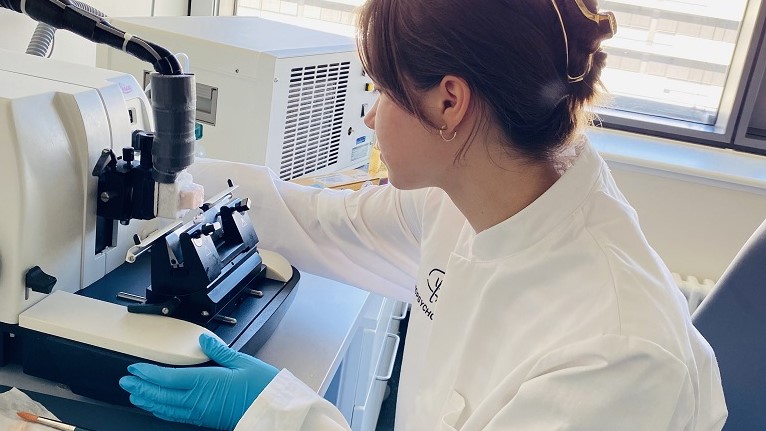
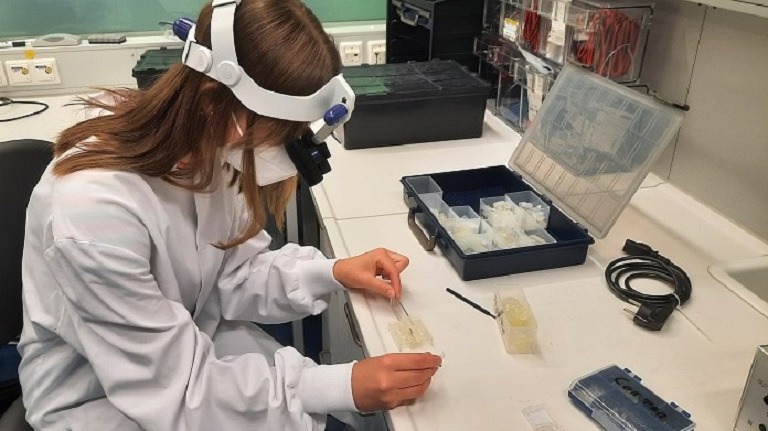
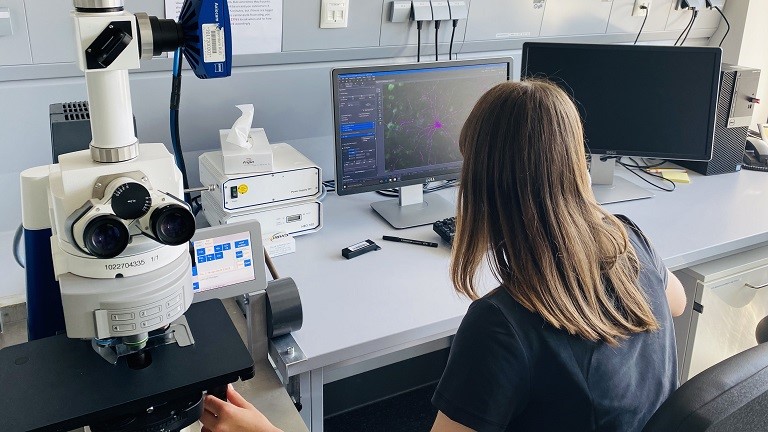
Cooperation with the zdi Netzwerk IST.Bochum.NRW
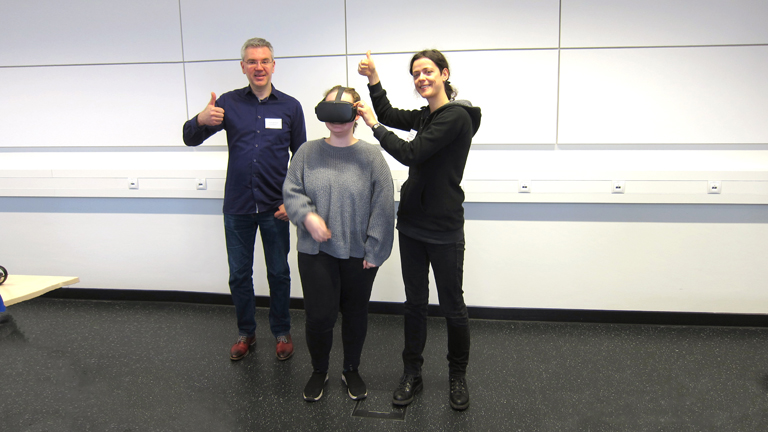
The Sonderforschungsbereich 874 has been cooperating with the network `Zukunft durch Innovation.NRW‘ (zdi) since 2017. The initiative is funded by the Ministry of Culture and Science of North Rhine-Westphalia and the Federal Employment Agency in North Rhine-Westphalia and aims to support the next generation of scientists and engineers in North Rhine-Westphalia.
Read moreAs part of the zdi cooperation, SFB researchers have taken on the scientific supervision of high school theses and other projects on neuroscientific topics. Typical of this initiative are practical projects in which students can develop their own scientific questions. Another part of our cooperation is the career orientation events of the Bochumer Ingenieurforums ‘BO.Ing’. High school students visit universities in Bochum and take lectures, laboratory tours and workshops in the ‘MINT’ subjects of mathematics, computer science, natural sciences and technology. Researchers from the SFB 874 offered the following workshops:
- 2019: “Small cells really big – Virtual microscopy of brain slices”
With the help of the virtual microscope, the students take a journey through the human body and get to know the most important structures and cell types of the nervous system.
- 2020: “Brain research in virtual reality (VR)”
In this workshop, the students use VR glasses and electroencephalography (EEG) to carry out their own experiment in virtual reality and then evaluate data themselves.
Internship at the SFB 874
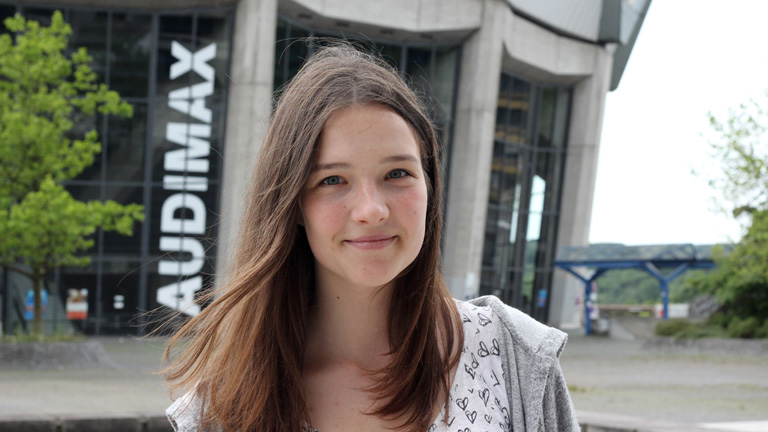
High-school graduate Kathrin Elmenhorst got insight into the research projects of the SFB 874 in a three week internship. Now she shares her experience in an interview.
Read moreInterview
Internship at the SFB 874
Three weeks between bird brains and EEG-studies .
As part of a three-week internship high-school graduate Kathrin Elmenhorst (19) got insight into the research projects of the Collaborative Research Center 874 (SFB 874). Now she shares her experience in an interview.
How did you come up with the idea for this internship?
After my graduation I spent some time in Chile. There I met someone who studies Psychology and we talked a lot about it. I realized that Psychology was more of a natural science than I thought. I was intrigued and started wondering if I should start to study Psychology as well. The internship is a way to find out if studying Psychology would suit me.
Your first station was department for Cognitive Psychology – what did you experience there?
I was surprised how much time the people took to explain everything to me. That applies to everyone during my internship, not only to the first station. The PhD-Students in the lab of Prof. Wolf for example explained their research projects to me and took me to lectures and seminars. I was really fascinated by the different methods of stressing the participants in their studies.
In your second week you visited the department of Biopsychology – what did you like most?
I was able to see how the students performed histological staining of brain cells and I was allowed to help with the preparation of a bird brain – that was really interesting! I did not expect that a bird’s brain looks so much like a human brain – even though their physiological structure differs from each other.
Which research project did you visit next?
In my third week I joined the research group for Developmental Neuropsychology of Sarah Weigelt. They took me along when they recruited new participants for a study. I really liked that, because it is an important part of the research process as well- I was able to experience every step of a research project during my internship from recruiting participants through to conducting experiments and analyzing the results. I also attended a lecture on the autism spectrum disorder by Sarah Weigelt which was really interesting.
You spend your last two days in the Neural Plasticity Lab of the Institut für Neuroinformatik. What did you learn there?
At first I wasn´t sure what to expect from Computational Neuroscience, because the topic is not taught in school. I attended an EEG-based study on neurofeedback and I was fascinated by the computer programmes they used in the study. I would really like to learn more about this in my studies.
Have you already decided what you are going to study?
I think the decision is really hard, because there are so many amazing options. I definitely think that Psychology is a great discipline but I might even choose a programme with a stronger focus on neuroscience. I have to think about that.
Interview: Judith Merkelt
Translation: Judith Merkelt and Julia Crispin
High School Thesis
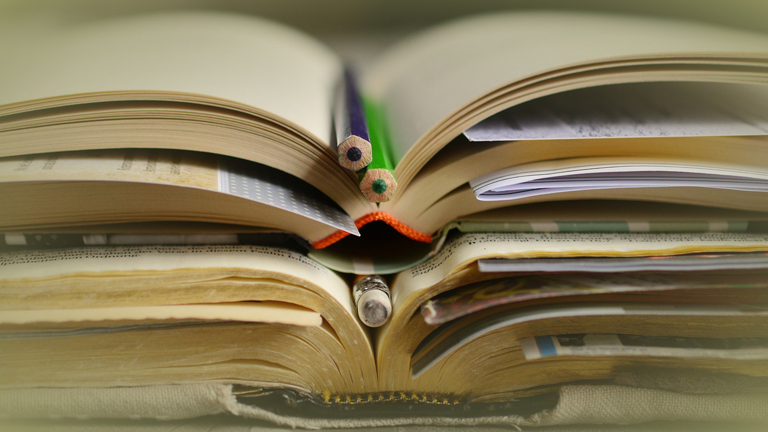
The Sonderforschungsbereich 874 supports interested high school students from Bochum in their first steps in the field of neuroscience. Anyone interested in a neuroscientific high school thesis can contact the SFB 874 with a specific topic suggestion at sfb874@rub.de. We would be happy to provide a neuroscientist as an scientific advisor.
Past Projects
Neuroscientific project days
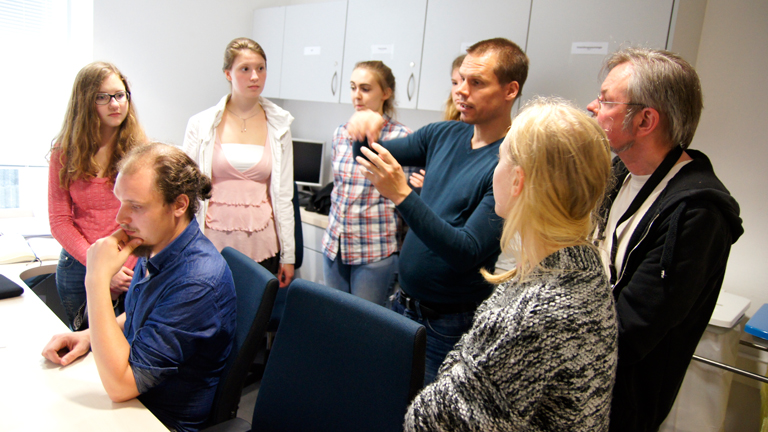
In 2016 Collaborative Research Centre 874 has once again opened the doors to neuroscience for students of Bochum’s Theodor-Körner-Schule. On four project days six grade 10 and 11 students were given a unique insight into very different neuroscientific research areas.
Read moreIn the departments for neurobiology, neuropsychology and cognitive neuroscience, as well as at the Neurological Clinic at the Bergmannsheil University Clinic the students were able to see and try out for themselves how different methods and approaches are used to investigate the fascinating world of our brain. One student has written a report on her impressions during the project – you can read it below (in German). We thank the participating scientists for taking the time for our guests and for speaking so vividly and with passion about their work.
Erfahrungsbericht
“Was geht einem durch den Kopf, wenn man an Neurowissenschaften denkt? Vielleicht denkt man, dem halbwegs vorhandenen Vorwissen aus “Grey’s Anatomy” sei Dank, an den groben, anatomischen Aufbau eines Gehirns. Vielleicht fallen einem sogar die Neuronen ein, ein Begriff, der im Biologieunterricht irgendwann einmal gefallen ist.
Was ich in den vier Tagen des Neurowissenschafts-Projekts gelernt habe, ist jedoch, dass die Neurowissenschaften viel umfangreicher sind, als ich es mir zu Beginn vorgestellt habe. Generell waren die Einblicke, die ich bekommen habe, anders, als ich es am Anfang erwartet habe.
Tag 1 & 2: Neurobiologie, Neuropsychologie – Von all den kennengelernten Themengebiete der Neurowissenschaften muss ich zugeben, dass mich Neurobiologie am wenigsten überrascht hat; was allerding keineswegs negativ zu sehen ist. Die informative Vorlesung beschäftigte sich genau mit dem, was ich erwartet hatte und wofür ich mich interessiere. Doch während die Neuropsychologievorlesung am zweiten Tag größtenteils eher eine Unterrichtswiederholung der zehnten Klasse in Pädagogik darstellte, kann ich durchaus sagen, am ersten Tag etwas über das Gehirn und dessen Funktionsweise gelernt zu haben, das mir bis dato zu mindestens nicht hundertprozentig schlüssig war.
Tag 3 & 4: Neuroinformatik, Neuromedizin – Da sich am Tag der Neuroinformatikvorlesung die Computer spontan zu einem Streik hinreißen ließen, blieb uns leider eine praxisnahe, eigene Erarbeitung der zuvor dargelegten Forschungsergebnisse der Ruhr-Universität verwehrt. Der vierte Termin war leider schon der letzte des Projektes, doch es war ein spannendes Ende, mit einem MRT-Besuch als Höhepunkt des ganzen Tages.
Neben dem Besuch im MRT konnten wir während der Projekttage natürlich durchaus mehrere, interessante Versuche durchführen: vom mikroskopischen Arbeiten an Zellen bis hin zur Veranschaulichung eines echten Gehirns im MRT.
Jetzt lässt sich meiner Meinung nach nur noch folgendes sagen: Nämlich, dass ich es nicht bereue, ganz im Gegenteil, dass ich sogar froh darüber bin, an diesem Projekt teilgenommen zu haben, denn auch wenn wir an diesen vier Tagen größtenteils nur an der Oberfläche der Bandbreite der Neurowissenschaften kratzen konnten, haben wir trotzdem vieles über die Neurowissenschaften erfahren können. Praxisnah.
Und hier möchte ich mich im Namen der Teilnehmer bei denjenigen bedanken, die sich für uns die Zeit genommen haben, uns deren Gebiet der Neurowissenschaften näher zu bringen. Vielen Dank für die schönen Tage!”
“Watching the brain at work”
– student project experiments with MRI
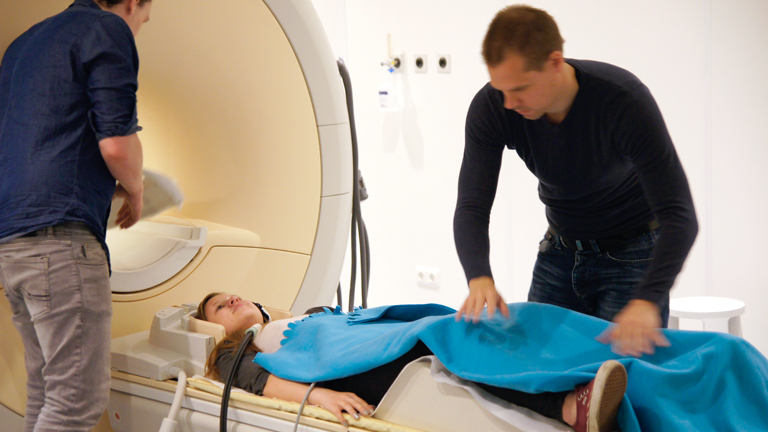
“Are you certain, you have no loose change in your pockets?” biologist Melanie Lenz makes sure. Dutifully the five students of the Theodor-Körner-School nod. Then they are led into a room marked by a big red sign: “Warning Magnetic Field!” The five students are now standing in front of a giant tube.
Read moreThey are looking at today’s center of attention and the pride of the RUB Research Department of Neuroscience: a 3 Tesla Magnetic Resonance Imaging Scanner. The apparatus weighs many tons; and since it was crane-lifted into the University Clinic Bergmannsheil five years ago, it has been at the center of many exciting research projects in neuroscience. The extremely strong 3 Tesla magnetic field (common in clinics are 1,5 Tesla scanners) makes extremely detailed and highly contrasted scans possible – and all this with a reduced scan-time. A magnetic field with only half its strength is able to effortlessly pick up a car. This is why it is vital to remove all metals before going near the scanner.
The visit to the Clinic for Neurology is the last stop of the “Neuroscience School Project” – a cooperation between the Collaborative Research Centre 874 and Bochum’s Theodor-Körner-School. Following Neurobiology and Neuropsychology, today’s excursion focuses on the cutting-edge functional MRI technology. The students’ tutor for the day is Prof. Dr. Schmidt-Wilcke. He is a senior physician at the Bergmannsheil, but also prinicipal investigator with the Collaborative Research Centre 874; and he works with the 3 Tesla MRI Scanner every day. “We want to watch the brain at work”, he explains and describes to the students how researchers work with the MRI technology to make neuronal activity visible. Scientists use the different magnetic properties of oxygen-rich blood and poorly oxygenated blood – the so-called BOLD-effect. When the brain is stimulated, the flow of blood in specific areas of the brain increases, the ratio of richly to poorly oxygenated blood changes, and slight fluctuations in the magnetic field occur. When the images of the stimulated brain are compared to the “rested” brain using statistical analysis, the stimulated areas of the brain can be made visible on a computer.
Then it is time for volunteers! While the theory is important, the students are also encouraged to experience neuroscientific research “hands-on”. 17-year-old Heiko lies down on the stretcher and Prof. Schmidt-Wilcke places the so-called “bird cage” on his head. This is a special head-coil, used to obtain high-resolution images. While Heiko is lying in the scanner, his classmates are watching him through a window in the console room. Just like in a real experiment, Heiko now has to complete a series of tests: taping with his finger or analyzing a row of letters. In between there are breaks, so that his brain can be scanned in a relaxed state.
Following the scan, students and scientists sit together to evaluate Heiko’s brain scans. Many statistical tests and calculations are necessary, before a clear image of the brain with highlighted areas can be viewed on the screen. This shows how mathematics is oftentimes just as important in neuroscience as anatomy. Finally, the desired image pops up on the screen: Heiko’s brain with yellow highlights in the motor cortex – the finger-tapping exercise!
With many new impressions, the students say goodbye to Prof Schmidt-Wilcke and his team. Today and over the past few weeks the “Neuroscience School Project” has shown them a whole new world besides their daily school routine. Perhaps this experience has awakened a spirit of research in some of them and, in a few years, we may see some familiar faces in the lecture halls of the Ruhr-Universität Bochum.
“A glitch in the brain” – High-school students visit department for neuropsychology
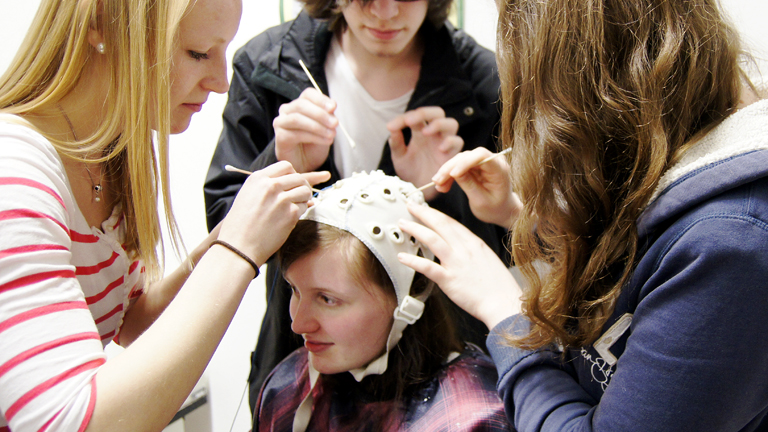
Kathrin sits calmly on a swivel chair. She is wearing something that looks like a bathing cap with holes, standing around her are four of her fellow students, each one of them is using a cotton bud to gingerly brush her hair aside, then they each add conductive gel, before finally attaching electrodes with long cables to her scalp. What looks a little like a futuristic hair dresser’s appointment is really hands-on neuroscience.
Read moreAs part of a cooperation between Collaborative Research Centre 874 and Bochum’s Theodor-Körner School, five high school students are on their second visit to the Ruhr-Universität Bochum in order to learn more about the exciting research field of neuroscience.
Their host today is Prof. Dr. Boris Suchan. He is principal investigator in the Collaborative Research Centre 874 and assistant professor of the Department of Clinical Neuropsychology at the RUB. He explains to the visiting students that neuropsychology is at the interface of medicine, neurology and psychology. Clinical Neuropsychology focuses on the diagnosis and treatment of disorders following brain damage. For this purpose the Ruhr-Universität Bochum runs its own neuropsychological therapy center, which is led by Mr. Suchan.
In an introductory lecture the students learn about the different regions of the brain, what their functions are and what happens, when, sometimes incredibly small, areas no longer function properly. There are for example people, who are not able to process and perceive stimuli on one side of their body or their environment. Neuropsychologists call this phenomena “neglect”. It often occurs with damage to the parietal lobe following, for example, a stroke. Even though these patients have no trouble with their vision, they are unable to focus their attention on one part of their field of vision or one half of their body. Individual therapy can help these patients, and in many cases a partial or complete remission of their neglect can be achieved. With the help of more such examples the students are shown how neuropsychologists learn more about the complex structure of the brain from its malfunctions – and how these findings can help in the development of therapy approaches.
In the EEG lab Kathrin and her fellow students receive some very practical insight into how modern technology can be used to diagnose brain disorders. Their eyes are glued to the computer screen as Kathrin’s brain waves are transmitted in real-time. Following the lecture, they know that electroencephalography can capture the weak electrical fields of our nerve cells through the scalp and then visualize brain activity. “But we can’t read your mind!” jokes Mr. Suchan. In fact the changes in the brain waves can reveal whether certain perceptions deviate from the norm. This method can, for instance, reveal prosopagnosia, or face-blindness.
During their last visit to the RUB the students were introduced to optogenetics – cutting edge research on a cellular level. Now the clinical approach of neuropsychology has given them insight into a completely different – but no less fascinating – area of the exciting research field of neuroscience.
Hands-on Neuroscience – Bochum high school students visit neurobiology department
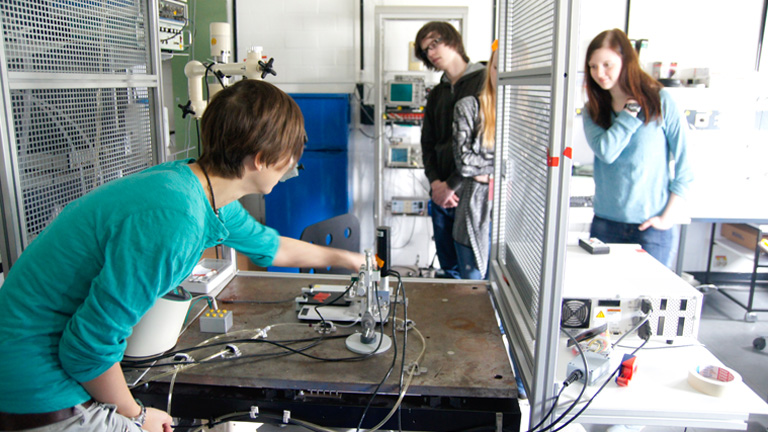
“I am sure of it: in the next few years optogenetics will receive a Nobel Prize”, with this Dr. Olivia Masseck welcomes her guests. Five grade 11 students of the Theodor-Körner School in Bochum-Dahlhausen are visiting the RUB’s department of general zoology and neurobiology.
Read moreAll have a keen interest in biology and chemistry which goes beyond the school syllabus. All of them are eager to find a course program at university that meets this interest. A cooperation with the Collaborative Research Centre 874 has given them the opportunity to get a taste for life as a neuroscientist and to visit different departments.
Dr. Olivia Masseck is the students’ first stop. She is herself an alumna of the Ruhr-Universität Bochum and of the International Graduate School of Neuroscience and she currently works as a Post-Doc under Prof. Herlitze. The students are introduced to her area of research, a fast-growing field that combines optical technologies and genetics. Optogenetics, a method by which genetically modified cells are activated using light, offers exciting opportunities for treating a host of diseases. The visitors learn how optogenetic methods could be used in the treatment of Parkinson’s disease, spinal cord injuries, blindness, diabetes and anxiety disorders.
Besides the scientific background the teenagers also learn much about life as a neuroscientist. How do you become a brain scientist? Do you sit in a lab all day? Will it make you rich? How do you exchange ideas with other scientists? And: will we ever completely understand how our brain works?
During a tour through the different labs of the department the students find out how diverse a scientist’s work is, which safety precautions must be observed and which high-quality resources scientists use for their work. One of these resources is the confocale microscope, an acquisition of the RUB’s Research Department of Neuroscience. With the help of Dr. Masseck the students are allowed to use this microscope to investigate how nerve cells are activated.
Their trip into the world of neuroscience has left the students fascinated. An interest in the work of scientists of the Collaborative Research Centre 874 has been sparked. Learning about optogenetics has shown them how diverse this field of study is and how much it relies on the exchange of scientific ideas from other areas. For this reason the Collaborative Research Center wants to invite the Theodor-Körner School to other departments in order to pass on our enthusiasm for neuroscience to the coming generation.
Living science
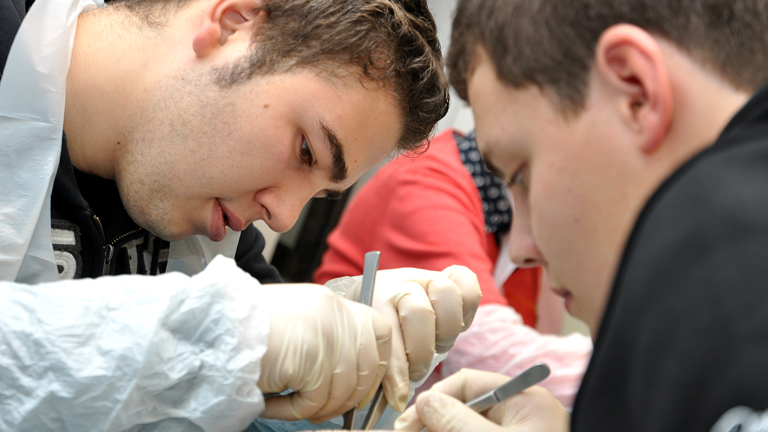
Scientific support at the transition from school to university cannot start early enough. Within the project HIGH SCHOOL THESIS the SFB 874 supports the first steps of interested pupils in the field of neuroscience.
Read moreSeveral pupils of an advanced course in Biology can experience living science while dissecting pigs’ brains during an orientation day organized by the SFB 874 last year. They for example separate the dura mater from the cerebrum in order to understand the brain’s structure in a very practical manner.
“We choose the bovire brain for the dissection, because it is structured in a very similar manner to our own brain”, Jun.-Prof. Dr. Nora Prochnow explains. She works within the Department of Neuroanatomy of the Medical Faculty and runs the orientation day under the motto “Brain anatomy”. The aim is to introduce high school pupils into the intriguing world of neuroscience. In the morning, Dr. Prochnow holds a theoretical lecture concerning the brain’s structure and functions, and in the afternoon the pupils gain practical experience. For most of them it is the first time in their lives that they see and dissect a mammalia brain and some might be interested in writing their high school thesis over a neuroscientific topic.
“Our course has proven very attractive.” Dr. Sabine Dannenberg, coordinator of the SFB 874 and responsible for the high school project, is satisfied with the pupils’ resonance. “We already placed several high-school pupils in contact with our neuroscientists who now supervise their high school project.” That means the scientist help to find relevant topics, provide necessary laboratory space and offer specialist exchange. Prof. Dr. Denise Manahan-Vaughan, speaker of the SFB 874 adds: “We offer a wide range of opportunities to high-school pupils, not least because neuroscience is highly multidisciplinary, but also because we have a long and established tradition at the Ruhr-Universität Bochum of interacting with pupils to foster their interest in this area.”
Anyone interested in a neuroscientific high school thesis can contact the SFB 874 at sfb874@rub.de.
